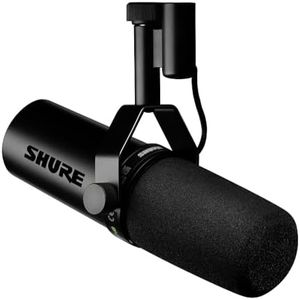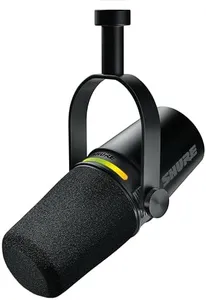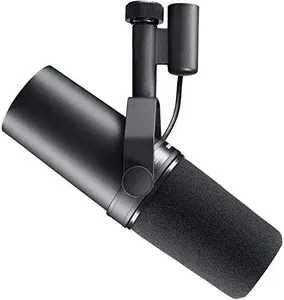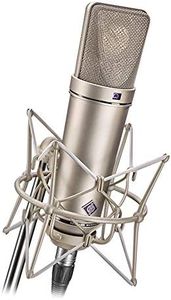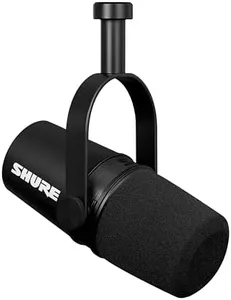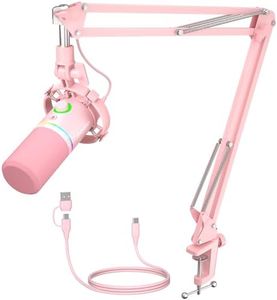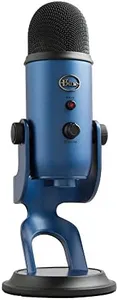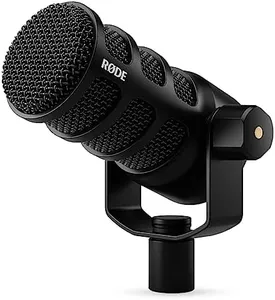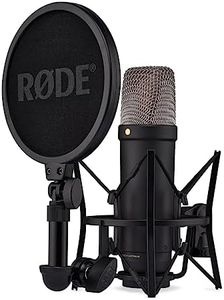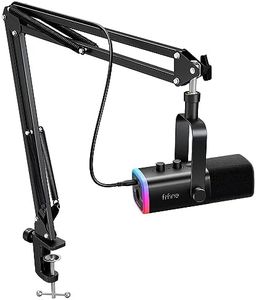10 Best Voice Over Microphone 2025 in the United States
Our technology thoroughly searches through the online shopping world, reviewing hundreds of sites. We then process and analyze this information, updating in real-time to bring you the latest top-rated products. This way, you always get the best and most current options available.

Our Top Picks
Winner
Shure SM7dB Dynamic Vocal Microphone with Built-in Preamp – Studio Mic for Streaming, Podcasting, and Recording – Smooth Sound, Wide Frequency Range, Rugged Build, Windscreen Included, Black
Most important from
12557 reviews
The Shure SM7dB is a dynamic vocal microphone especially suited for streaming, podcasting, and recording. Its unidirectional (cardioid) polar pattern helps isolate your voice from background noise, making it a solid choice for less-than-perfect recording environments. With a wide frequency response from 50Hz to 20kHz, it captures a warm, smooth sound that's popular among broadcasters and content creators.
A standout feature is its built-in preamp, which offers selectable gain boosts (+18dB or +28dB) to handle both quiet and loud sound sources without needing extra gear. This flexibility helps simplify your setup, especially if you want to avoid bulky external preamps. The microphone also includes tone-shaping switches to tailor the sound to your voice or instruments. Build quality is rugged and reliable, consistent with Shure's reputation, and it comes with a detachable windscreen to reduce plosives.
Connectivity uses a standard XLR connection, meaning you’ll need an audio interface or mixer with phantom power to use the preamp. While it weighs a bit more than typical mics, that adds to its sturdy feel. Some users may find the need for phantom power and XLR cables less convenient than USB mics, especially beginners, but for anyone serious about clear, professional-sounding voice recordings, the SM7dB delivers excellent performance with fewer accessories to worry about.
Most important from
12557 reviews
Shure MV7+ Podcast Dynamic Microphone – OBS Certified, Enhanced Audio, LED Panel, USB-C & XLR Outputs, Auto Level Mode, Digital Pop Filter, Reverb Effects – For Podcasting, Streaming, Recording, Black
Most important from
3934 reviews
The Shure MV7+ is a solid choice for anyone looking to step up their podcasting, streaming, or recording game with a professional-quality microphone. Its unidirectional dynamic design helps focus on your voice while reducing background noise, which makes it great for less-than-perfect recording environments. The frequency response and sensitivity are tuned to capture clear and natural sound, giving your voice a warm and detailed quality.
One standout feature is its dual connectivity—USB-C for easy plug-and-play with computers and XLR for more advanced setups—offering flexibility no matter your experience level. The built-in LED touch panel is a nice touch, letting you mute quickly and monitor your levels visually, which is handy during live sessions. Additionally, the auto level mode automatically adjusts your volume as you move, and the real-time denoiser cleans up background sounds, useful for home recordings or noisy spaces. The onboard reverb effects add professional depth, especially if you want a richer sound for music or voice performances.
On the downside, while the microphone has many features, some may find the price a bit high compared to simpler USB mics. Also, its heavier metal build, while durable, makes it less portable if you plan to travel with it. The LED panel, though attractive, might be unnecessary for those who prefer a minimalist setup. Taking all factors into account, the Shure MV7+ suits podcasters, streamers, and content creators who want a versatile, high-quality mic that adapts to different setups and environments, balancing ease of use with professional features.
Most important from
3934 reviews
Shure SM7B Vocal Dynamic Microphone – XLR Studio Mic for Podcasting, Recording, Broadcasting, Streaming & Gaming – Smooth, Warm Sound, Rugged Build, Detachable Windscreen, Wide Frequency Range, Black
Most important from
12556 reviews
The Shure SM7B is a highly regarded dynamic microphone, well-suited for various applications like podcasting, broadcasting, and studio recording. One of its standout strengths is its versatile nature; it excels in capturing vocals and instruments with a smooth, natural sound. The unidirectional polar pattern effectively reduces background noise, making it a great choice for environments where sound clarity is essential. Additionally, the air suspension shock isolation and built-in pop filter help minimize unwanted noise from breathing and mechanical sounds, ensuring that your voice comes through cleanly.
Another notable feature is its robust build quality, designed to withstand the rigors of daily use. The detachable windscreens add to its usability, allowing you to customize it for different recording situations. The XLR connection also provides flexibility for connecting to audio interfaces, which is ideal for those looking to achieve a professional sound.
The SM7B does require a significant amount of gain to achieve optimal performance, which may necessitate the use of additional preamps or audio interfaces. This might be a challenge for users who are new to audio equipment or those on a budget. Furthermore, being a dynamic microphone, it may not capture the same level of detail as condenser microphones, which some users prefer for specific applications like voice-over work or detailed music recordings.
Most important from
12556 reviews
Buying Guide for the Best Voice Over Microphone
Choosing the right voice-over microphone is crucial for achieving high-quality audio recordings. Whether you're a podcaster, voice actor, or content creator, the right microphone can make a significant difference in the clarity and richness of your voice. To make an informed decision, it's important to understand the key specifications and how they align with your specific needs and recording environment.FAQ
Most Popular Categories Right Now


